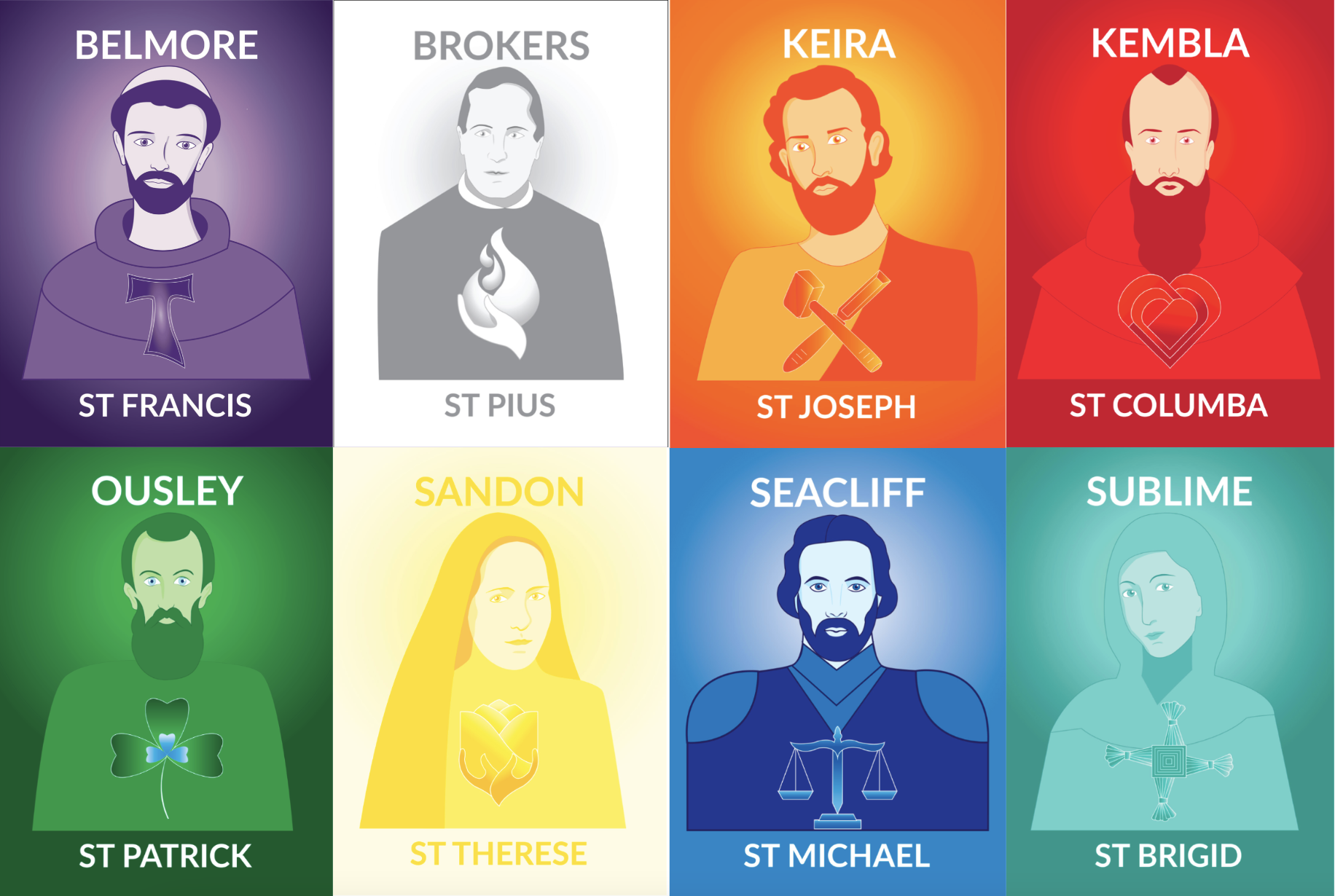
College House System
Holy Spirit College, Bellambi has embarked on a journey to acknowledge all the achievements of our students. Our house system celebrates the values of our catholic faith, the natural beauty of the Illawarra and competition for the House Cup.
College House Structure
In 2023 the College introduced a new House System for all students and staff. The House determines the students' Homeroom group. The College House System is made up of 8 Houses named after significant geographic regions in the Illawarra area and are aligned with a Patron Saint and Feast Day.
The House System creates a positive climate of healthy competition and rivalry between the House Groups. Associated activities are held, intended to cultivate a sense of belonging whilst also adding fun, energy, enthusiasm and celebration to the daily experience of the College.
House Points
Students collect points across a broad range of areas of College life. The system has been designed to allow students to collect points across Catholic life, extracurricular, sporting and academic endeavours. The entry of points will be completed through Compass and is the responsibility of the coordinating staff member of that endeavour. Ultimate discretion for the allocation of points and appeals will be resolved by the House Coordinator.
Student Leadership
Student Leadership at Holy Spirit College is based upon the servant leadership model of Jesus Christ. This is most clearly evident in Jesus’ washing of the disciples’ feet (John 13: 1-17). In this action, Jesus demonstrates the humility and service required of humanity in building the Kingdom of God.
Student Leadership is focused on building the culture of the Houses and increasing the capacity of individual students to enhance their leadership skills. The structure is centrally based on the Student Representative Council (SRC) which is ideally democratically representative of the student body. Where required, discretion is given to the Principal (or Principal's delegate) to ensure the structure is representative of student activities and groups at the College.
The SRC will encompass:
The student leadership team (2 x College Captains, 2 x Vice Captains, 2 x Sports Captains)
Year 12 House Captains (2 per House)
Year 8-11 House Leader (1 per House)
Plus any additional representatives from other student groups not represented in the SRC (at the Principal’s Discretion)
-
Belmore House is named after Belmore Basin located in the Wollongong CBD. Belmore Basin played a significant role in the early development of Wollongong as a busy sea port and has transformed into a place for families to come together and enjoy where the Central Business District (CBD) meets the sea.
Belmore’s Patron Saint is Saint Francis of Assisi. Francis began an early informal ministry, with few followers, before seeking formal approval from the Pope which later developed into the Franciscan Orders. Francis’ passion for the natural world emanated in all that he did, praising creation at every chance. Francis is heralded as the first person to create a live nativity scene (1223), recognising the significance of Jesus’ birth and hence the inherent connection of Christianity to the natural world. Pope John Paul II declared him the Patron Saint of Ecology on 29 November 1979 and used his legacy to challenge Catholics throughout the world to uphold their commitment to care for creation.
At its core Belmore is renowned for Stewardship. Belmore students can look to Psalm 24:1 for guidance: “The earth and everything in it, the world and its inhabitants, belong to the Lord.”
Belmore’s purple colour symbolises sacrifice and balance. Students of Belmore recognise the sacrifice of St Francis to live humbly and in harmonious balance with all of God’s creation. Similarly, purple is equal parts red and blue. Both of these factors remind students of Belmore to build their relationship with God and with all creation to fulfil their true potential. The Tau Cross symbolises St Francis’ devotion to God and keeper of all God’s creations. This underpinned his approach of Stewardship in his everyday life. Belmore’s design consists of a smaller cross (representative of the junior years) placed in front of the larger cross (the senior years) standing tall together to be caretakers of all creation, including each other.
-
Brokers House is named after the mountain peak Brokers Point, or Brokers Nose as it is commonly known by locals. Brokers Nose is a prominent lookout location which is accessed by an unmarked trail.
The House’s Patron Saint is St Pius X. In his early years he was known for his exuberant and energetic demeanour, renowned for being committed to his education. He was offered a scholarship to continue his studies and was ordained as a Priest in 1858. Elected to the Papacy in 1903 he devoted his period of service to Instaurare Omnia in Christo, “to restore all things in Christ.” Pius was dedicated to building the Kingdom of God on Earth. He reformed the Liturgical Movement to enable greater participation of the faithful and lowered the First Holy Communion age to permit the sharing of this gift with more of the faithful. Pius was a person of action, often seen in the streets of Italy with large groups of people. He is renowned for his compassionate action towards refugees; after the Messina Earthquake of 1908 he filled the Apostolic Palace with people prior to the national government response.
At its core Brokers is renowned for Community. To guide Brokers students should look to the Gospel of St. Matthew 23:37-39 “Love your neighbour as yourself.”
The colour white represents pureness of heart, evident in St Pius’ deeds and values. Brokers’ symbol of the white flame held by a hand, represents each year group within Brokers. The smallest flame represents Years 7 and 8, the second Years 9 and 10 and the two larger flames represent Years 11 and 12. In this manner, the flames depict the responsibility of senior students in modelling faith and service to those in the years below. The hand is a visible reminder of the living example of St Pius and his never-ending concern for those in need. Supported by the teachings and example of St Pius, Brokers students can ignite their own flames to serve their College and wider community through their faith.
-
Keira House is named after the mountain peak Mount Keira. Mount Keira Summit Park is an annex to the Wollongong Botanic Garden. The area houses significant Aboriginal cultural heritage sites and amazing views across the Illawarra.
The House’s Patron Saint is St Joseph. St Joseph, the earthly foster father of Jesus, was a carpenter, a career documented to have been followed by Jesus. Joseph’s faith is most evident in his virtuous trust in God. This faith remained steadfast, even in the midst of the annunciation, the dangerous journey to Bethlehem and murderous intent of Herod. Today, the mission of Joseph continues with the work of many, including the Sisters of St Joseph founded in Australia by Saint Mary Mackillop and Fr Julian Tension Woods.
At its core Keira is renowned for Commitment. To guide Keira students should look to the Book of Proverbs (16:3) “Commit to the Lord whatever you do”.
Keira’s colour, orange, is directly associated with enthusiasm and determination; and is also the combination of colours associated with St Joseph, gold and red. The hammer and chisel are symbolic of a carpenter and the everyday work of “committing to the Lord whatever you do”. It reminds students that through our actions, and taking responsibility for our actions, we renew our commitment to God. The etchings on the handles of hammer and chisel are a call to Keira students to take up their commitment to spiritual and holistic growth.
-
Kembla House is named after the mountain peak Mount Kembla. The area is characterised by steep topography leading up to the summit that overlooks the Illawarra region, particularly the southern region encompassing Lake Illawarra.
The House’s Patron Saint is St Columba. A poet, prophet and monk of royal Irish heritage, Columba felt the priesthood was his calling. His work in Ireland and Britain has seen him recognised as one of the three patron Saints of Ireland. Columba’s contribution led to the construction of countless monasteries across Ireland without ever cutting down a single tree. This is characteristic of his deep love for God’s creation. Part of his creative work saw three of his Gaelic hymns continue to be used today including: “The King of Love My Shepherd Is”.
At its core Kembla is renowned for Love. To guide Kembla students look to 1 John 4:8 “God is love”.
Kembla’s colour, red, is the universal symbol for love, a fitting representation of St Columba and Kembla. They are symbolised by a heart, the motif for St Columba who is renowned for the value of Love. The heart is made up of 6 sections, representing each year group, all coming together to make up Kembla. Like any heart, each year group has an important role in fostering love and compassion towards themselves, each other and the wider community. With all its members committing to this, Kembla students can ensure their choices and deeds come from a place that befits the example of St Columba.
-
Ousley House is named after the mountain peak Mount Ousley. This area contains the main interconnecting road between the Illawarra and the Sydney region. When returning to the Illawarra this area is one of the first visual connections that locals make with their home.
The House’s Patron Saint is St Patrick. He is one of the Patron Saints of Ireland, often referred to as the Apostle of Ireland, being credited for bringing Christendom to the country. During his early life St Patrick faced severe hardship including slavery, starvation and kidnapping. However, he remained true to his mission of evangelisation, even under the constant danger of martyrdom. St Patrick’s writings during his life were often criticised for their incoherence, it was not until after his death that theologians truly appreciated his moral and spiritual greatness.
At its core Ousley is renowned for its Mission. To guide Ousley students look to the Gospel of St. Mark (16:15) “Go into all the world and preach the Good News to everyone.”
St Patrick spread the word of God for forty years with the use of the three leaf clover; a simple way to explain the Holy Trinity to non-Christians. Naturally as the clover is green, St Patrick has also become synonymous with the colour. Ousley’s clover is made up of six parts, a smaller three leaf clover to represent the junior years, placed within the three leaf clover representing the senior years. The placement of the junior school within the senior school symbolises the growth of Mission from the junior years into the senior years and beyond.
-
Sandon House is named after Sandon Point Beach. Sandon Point Beach is a 900m long stretch of beach that is a popular surfing spot for locals and offers a large reserve for picnicking.
The House’s Patron Saint is St Therese. Therese lost her mother at a young age in 1886 and attributed her complete conversion to the ‘miracle God worked on her that night’. She has been highly influential and revered for her simplicity and practical approach to spiritual life. Therese’s accomplishments were appreciated after her death, particularly her spiritual writings. She focussed on small acts of charity, care for others, and practising acts of kindness.
At its core Sandon House is renowned for Humility. To guide Sandon students will look to the Gospel of St. Matthew (23:12) “...all those who humble themselves will be exalted”.
St Therese has become synonymous with the ‘Little Flower’. Her poetry depicted her love of nature and presents imagery conveying her belief that the Divine presence is everywhere. Hence, Sandon House is symbolised by the flower. It’s petals represent each year group, starting at the top with Year 7. Each year then envelops the previous year through to Year 12. Students in Sandon House will strive to uphold the values of humility, friendship and optimism, values associated with the colour yellow.
-
Seacliff House is named after the picturesque sea cliffs nestled between Clifton and Coalcliff. The area has developed an international identity for the famous Seacliff Bridge that links the Northern Illawarra.
The House’s Patron Saint is St Michael. Whilst not a Saint in the traditional sense, he is in fact an Archangel, the leader of all angels and the army of God. Roman Catholics allocate four roles to Saint Micahel; the first, Enemy of Satan and fallen angels. The second, he is the Christian angel of death - providing an opportunity of redemption before passing. Thirdly, weighing people’s merits on judgement day. Finally, he is the Guardian of the Church.
At its core Seacliff is renowned for Justice. To guide Seacliff they look to Isaiah 1:17 “pursue justice and rescue the oppressed”.
Seacliff is associated with the colour blue, as it not only symbolises wisdom, calm, trust, sincerity and faith but it is also associated with communication skills such as listening and speaking. These attributes are valuable when responding to issues of justice and providing a voice for those unable to speak for themselves. The symbol for Seacliff is the scales of justice upheld by the sword of protection. The different year groups are represented by the ropes holding the scales. The sword through the middle of the scales emphasises the divine right of justice in the sight of St. Michael. Since St Michael is considered the Divine protector, students in Seacliff can look to his example of not only standing for justice but pursuing justice and offering protection to others around them.
-
Sublime House is named after the Sublime Point summit on the Illawarra escarpment. The iconic walking track is famous with the locals for its challenging gradient, numerous ladders and rock ledges.
St Brigid, born in Ireland c450 AD is the Patron Saint of Sublime House. Despite being born into slavery, St Brigid was remarkably generous, unable to keep herself from feeding the poor and healing them. This frustrated her controller to the point where he tried to sell her to the King. In response St Brigid gave away the King’s sword to a beggar. The King, a Christian himself, convinced St Brigid’s controller to grant her freedom. Following her manumission Brigid entered a life in the Church, founding a monastery and organising a communal consecrated religious life for women in Ireland.
At its core Sublime is renowned for the virtue of charity. Sublime students will be guided by the Acts of the Apostles (20:35) “It is more blessed to give than to receive”.
The colour turquoise is associated with the value of compassion, evoked by empathy. These qualities are evident when we make selfless decisions and behave positively towards others. The cross made from reeds is one St Brigid herself created whilst tending to a pagan King on his deathbed. Whilst she weaved St Brigid explained to the King what the cross represented. As a result he converted and was baptised a Christian moments before he died. Hence, the cross, now known as St Brigid’s Cross, not only represents Christianity but the charitable nature for which St Brigid was so well known.
The logo for Sublime is subsequently St Brigid’s cross. Each section of the cross consists of six reeds, representing the six years groups. The interconnection of the reeds, and their formation into the sign of the cross, indicates the compassion Sublime students demonstrate both within and beyond the College community. Through their empathy and compassion, Sublime students should always view the world around them with open minds, hearts and generous spirits.
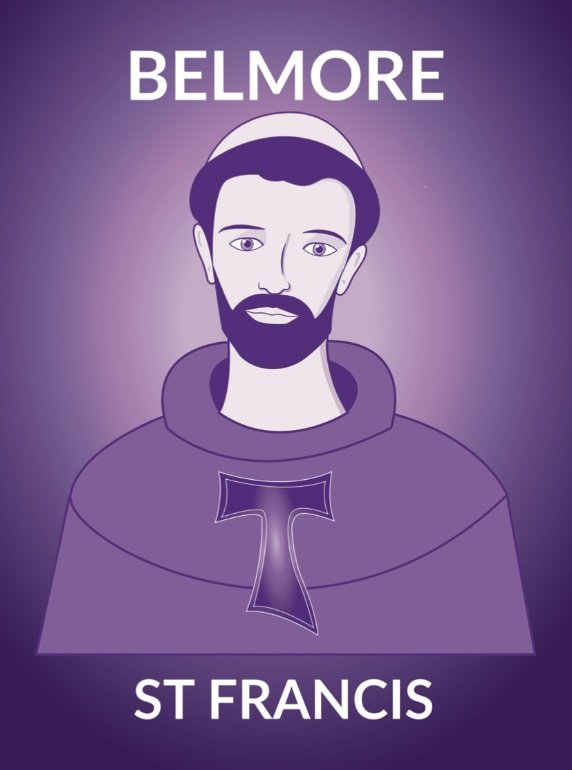
Belmore House is named after Belmore Basin located in the Wollongong CBD. Belmore Basin played a significant role in the early development of Wollongong as a busy sea port and has transformed into a place for families to come together and enjoy where the Central Business District (CBD) meets the sea. Belmore’s Patron Saint is Saint Francis of Assisi. Francis began an early informal ministry, with few followers, before seeking formal approval from the Pope which later developed into the Francisan Orders. Francis’ passion for the natural world eminanted in all that he did, praising creation at every chance. Francis is heralded as the first person to create a live nativity scene (1223), recognising the significance of Jesus’ birth and hence the inherent connection of Christianity to the natural world. Pope John Paul II declared him the Patron Saint of Ecology on 29 November 1979 and used his legacy to challenge Catholics throughout the world to uphold their commitment to care for creation. At its core Belmore is renowned for Stewardship. Belmore students can look to Psalm 24:1 for guidance: “The earth and everything in it, the world and its inhabitants, belong to the Lord.” Belmore’s purple colour symbolises sacrifice and balance. Students of Belmore recognise the sacrific of St Francis to live humbly and in harmonious balance with all of God’s creation. Similarly, purple is equal parts red and blue. Both of these factors remind students of Belmore to build their relationship with God and with all creation to fulfil their true potential. The Tau Cross symbolises St Francis’ devotion to God and keeper of all God’s creations. This underpinned his approach of Stewardship in his everyday life. Belmore’s design consists of a smaller cross (representative of the junior years) placed in front of the larger cross (the senior years) standing tall together to be caretakers of all creation, including each other.
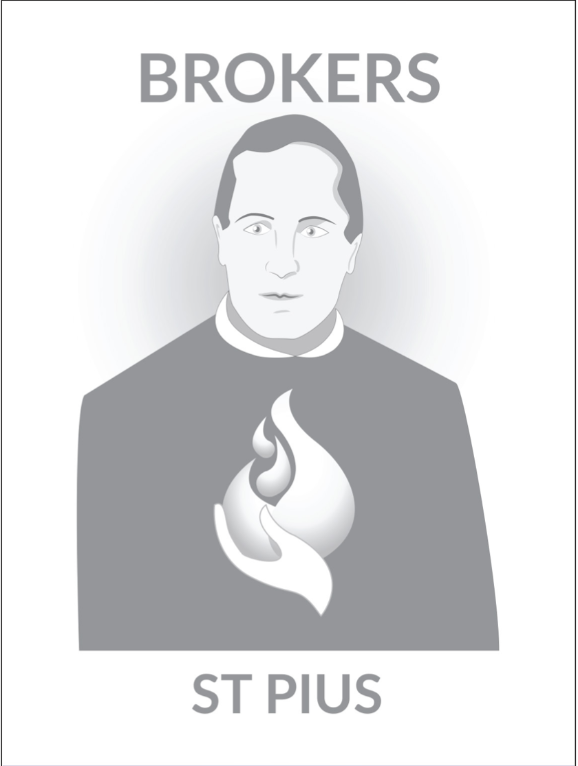
Brokers House is named after the mountain peak Brokers Point, or Brokers Nose as it is commonly known by locals. Brokers Nose is a prominent lookout location which is accessed by an unmarked trail. The House’s Patron Saint is St Pius X. In his early years he was known for his exuberant and energetic demeanour, renowned for being committed to his education. He was offered a scholarship to continue his studies and was ordained as a Priest in 1858. Elected to the Papacy in 1903 he devoted his period of service to Instaurare Omnia in Christo, “to restore all things in Christ.” Pius was dedicated to building the Kingdom of God on Earth. He reformed the Liturgical Movement to enable greater participation of the faithful and lowered the First Holy Communion age to permit the sharing of this gift with more of the faithful. Pius was a person of action, often seen in the streets of Italy with large groups of people. He is renowned for his compassionate action towards refugees; after the Messina Earthquake of 1908 he filled the Apostolic Palace with people prior to the national government response. At its core Brokers is renowned for Community. To guide Brokers students should look to the Gospel of St. Matthew 23:37-39 “Love your neighbour as yourself.” The colour white represents pureness of heart, evident in St Pius’ deeds and values. Brokers symbol of the white flame held by a hand, represents each year group within Brokers. The smallest flame represents Years 7 and 8, the second Years 9 and 10 and the two larger flames represent Years 11 and 12. In this manner, the flames depict the responsibility of senior students in modeling faith and service to those in the years below. The hand is a visible reminder of the living example of St Pius and his never ending concern for those in need. Supported by the teachings and example of St Pius, Brokers students can ignite their own flames to serve their College and wider community through their faith.
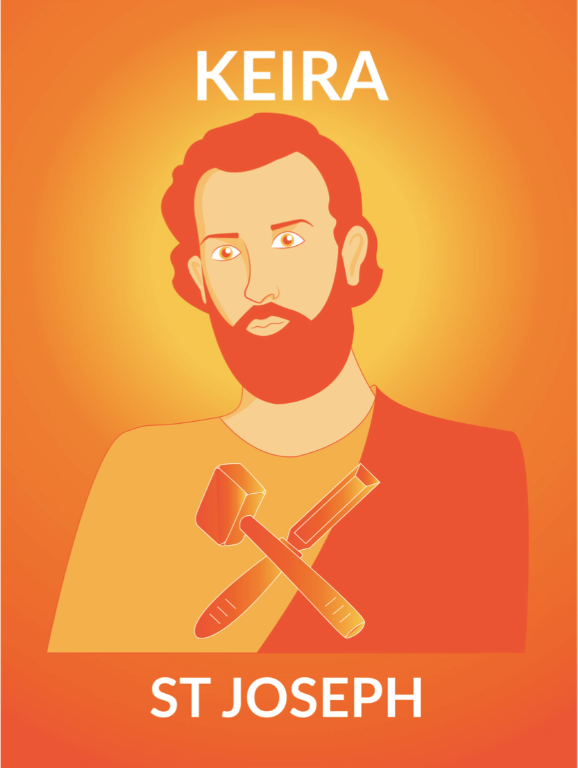
Keira House is named after the mountain peak Mount Keira. Mount Keira Summit Park is an annex to the Wollongong Botanic Garden. The area houses significant Aboriginal cultural heritage sites and amazing views across the Illawarra. The House’s Patron Saint is St Joseph. St Joseph, the earthly foster father of Jesus, was a carpenter, a career documented to have been followed by his Jesus. Joseph’s faith is most evident in his virtuous trust in God. This faith remained steadfast, even in the midst of the annunciation, the dangerous journey to Bethlehem and murderous intent of Herod. Today, the mission of Joseph continues with the work of many including the Sisters of St Joseph founded in Australia by Saint Mary Mackillop and Fr Julian Tension Woods. At its core Keira is renowned for Commitment. To guide Keira students should look to the Book of Proverbs (16:3) “Commit to the Lord whatever you do”. Keira’s colour, orange, is directly associated with enthusiasm and determination; and is also the combination of colours associated with St Joseph, gold and red. The hammer and chisel are symbolic of a carpenter and the everyday work of “commiting to the Lord whatever you do”. It reminds students that through our actions, and taking responsibility for our actions, we renew our commitment to God. The etchings on the handles of hammer and chisel are a call to Keira students to take up their commitment to spiritual and holistic growth.
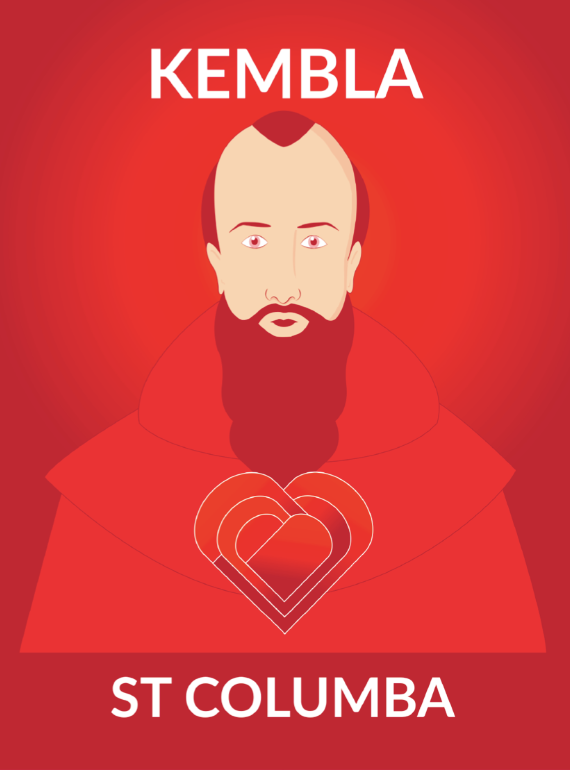
Kembla House is named after the mountain peak Mount Kembla. The area is characterised by steep topography leading up to the summit that overlooks the Illawarra region, particularly the southern region encompassing Lake Illawarra. The House’s Patron Saint is St Columba. A poet, prophet and monk of royal Irish heritage, Columba felt the priesthood was his calling. His work in Ireland and Britain has seen him recognised as one of the three patron Saints of Ireland. Columba’s contribution led to the construction of countless monasteries across Ireland without ever cutting down a single tree. This is characteristic of his deep love for God’s creation. Part of his creative work saw three of his Gaelic hymns continue to be used today including: “The King of Love My Shepherd Is”. At its core Kembla is renowned for Love. To guide Kembla students look to 1 John 4:8 “God is love”. Kembla’s colour, red, is the universal symbol for love, a fitting representation of St Columba and Kembla. They are symbolised by a heart, the motif for St Columba who is renowned for the value of Love. The heart is made up of 6 sections, representing each year group, all coming together to make up Kembla. Like any heart, each year group has an important role in fostering love and compassion towards themselves, each other and the wider community. With all its members committing to this, Kembla students can ensure their choices and deeds come from a place that befits the example of St Columba.
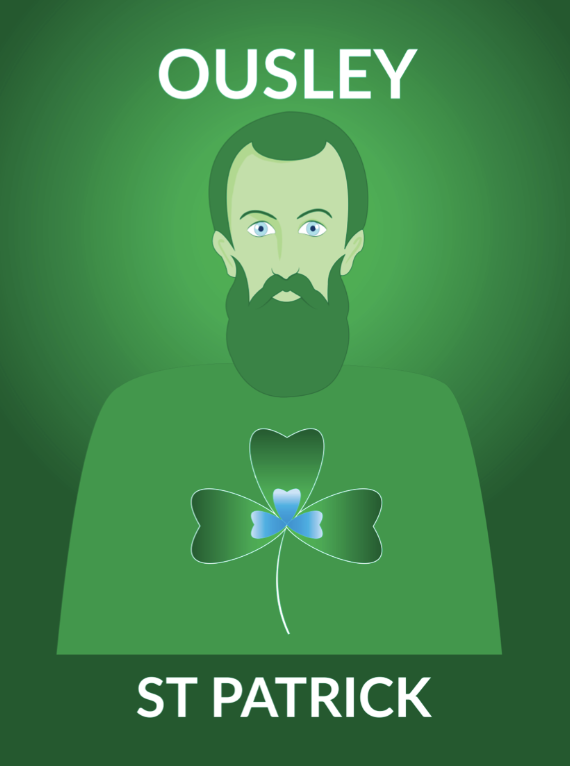
Ousley House is named after the mountain peak Mount Ousley. This area contains the main interconnecting road between the Illawarra and the Sydney region. When returning to the Illawarra this area is one of the first visual connections that locals make with their home. The House’s Patron Saint is St Patrick. He is one of the Patron Saints of Ireland, often referred to as the Apostle of Irlend, being credited for bringing Christendom to the country. During his early life St Patrick faced severe hardship including slavery, starvation and kidnapping. However, he remained true to his mission of evangelisation, even under the constant danger of martyrdom. St Patrick’s writings during his life were often criticised for their incoherence, it was not until after his death that theologians truly appreciated his moral and spiritual greatness. At its core Ousley is renowned for its Mission. To guide Ousley students look to the Gospel of St. Mark (16:15) “Go into all the world and preach the Good News to everyone.” St Patrick spread the word of God for fourty years with the use of the three leaf clover; a simple way to explain the Holy Trinity to non-Christians. Naturally as the clover is green, St Patrick has also become synonymous with the colour. Ousley’s clover is made up of six parts, a smaller three leaf clover to represent the junior years, placed within the three leaf clover representing the senior years. The placement of the junior school within the senior school symbolises the growth of Mission from the junior years into the senior years and beyond.
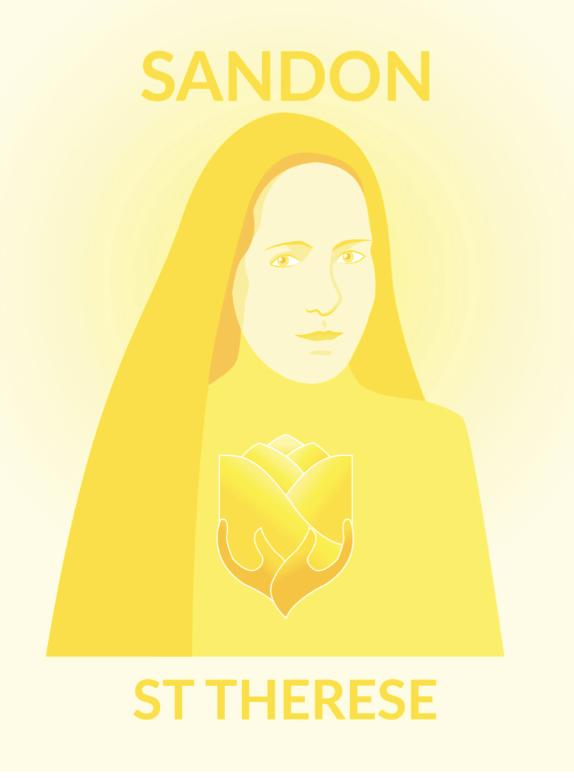
Sandon House is named after Sandon Point Beach. Sandon Point Beach is a 900m long stretch of beach that is a popular surfing spot for locals and offers a large reserve for picnicing. The House’s Patron Saint is St Therese. Therese lost her mother at a young age in 1886 and attributed her complete conversion to the ‘miracle God worked on her that night’. She has been highly influential and revered for her simplicity and practical approach to spiritual life. Therese’s accomplishments were appreciated after her death, particularly her spiritual writings. She focussed on small acts of charity, care for others, and practicing acts of kindness. At its core Sandon House is renowned for Humility. To guide Sandon students will look to the Gospel of St. Matthew (23:12) “...all those who humble themselves will be exalted”. St Therese has become synonymous with the ‘Little Flower’. Her poetry depicted her love of nature and presents imagery conveying her belief that the Divine presence is everywhere. Hence, Sandon House is symbolised by the flower. It’s petals represent each year group, starting at the top with Year 7. Each year then envelopes the previous year through to Year 12. Students in Sandon House will strive to uphold the values of humility, friendship and optimism, values associated with the colour yellow.
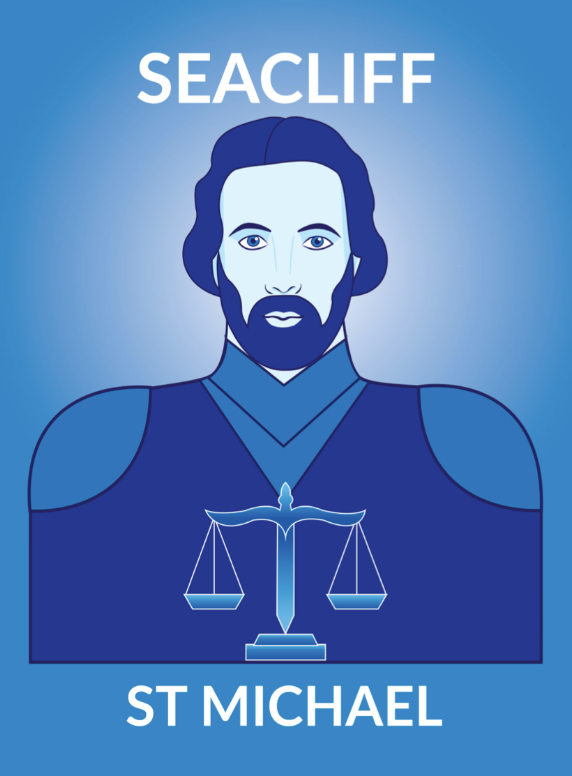
Seacliff House is named after the picturesque sea cliffs nestled between Clifton and Coalcliff. The area has developed an international identity for the famous Seacliff Bridge that links the Northern Illawarra. The House’s Patron Saint is St Michael. Whilst not a Saint in the traditional sense, he is in fact an Archangel, the leader of all angels and the army of God. Roman Catholics allocate four roles to Saint Micahel; the first, Enemy of Satan and fallen angels. The second, he is the Christian angel of death - providing an opportunity of redemption before passing. Thirdly, weighing peoples’ merits on judgement day. Finally, the Guardian of the Church. At its core Seacliff is renowned for Justice. To guide Seacliff they look to Isaiah 1:17 “pursue justice and rescue the oppressed”. Seacliff is associated with the colour blue, as it not only symbolises wisdom, calm, trust, sincerity and faith but it is also associated with communication skills such as listening and speaking. These attributes are valuable when responding to issues of justice and providing a voice for those unable to speak for themselves. The symbol for Seacliff is the scales of justice upheld by the sword of protection. The different year groups are represented by the ropes holding the scales. The sword through the middle of the scales emphasises the divine right of justice in the sight of St. Michael. Since St Michael is considered the Divine protector, students in Seacliff can look to his example of not only standing for justice but pursuing justice and offering protection to others around them.

Sublime House is named after the Sublime Point summit on the Illawarra escarpment. The iconic walking track is famous with the locals for its challenging gradient, numerous ladders and rock ledges. St Brigid, born in Ireland c450 AD is the Patron Saint of Sublime House. Despite being born into slavery, St Brigid was remarkably generous, unable to keep herself from feeding the poor and healing them. This frustrated her controller to the point where he tried to sell her to the King. In response St Brigid gave away the King’s sword to a beggar. The King, a Christian himself, convinced St Brigid’s controller to grant her freedom. Following her manumission Brigid entered a life in the Church founding a monastery and organising a communal consecrated religious life for women in Ireland. At its core Sublime is renowned for the virtue of charity. Sublime students will be guided by the Acts of the Apostles (20:35) “It is more blessed to give than to receive”. The colour turquoise is associated with the value of compassion, evoked by empathy. These qualities are evident when we make selfless decisions and behave positively towards others. The cross made from reeds is one St Brigid herself created whilst tending to a pagan King on his deathbed. Whilst she weaved St Brigid explained to the King what the cross represented. As a result he converted and was baptised a Christian moments before he died. Hence, the cross, now known as St Brigid’s Cross, not only represents Christianity but the charitable nature for which St Brigid was so well known. The logo for Sublime is subsequently St Brigid’s cross. Each section of the cross consists of six reeds, representing the six years groups. The interconnection of the reeds, and there formation into the sign of the cross, indicates the compassion Sublime students demonstrate both within and beyond the College community. Through their empathy and compassion, Sublime students should always view the world around them with open minds, hearts and generous spirits.
